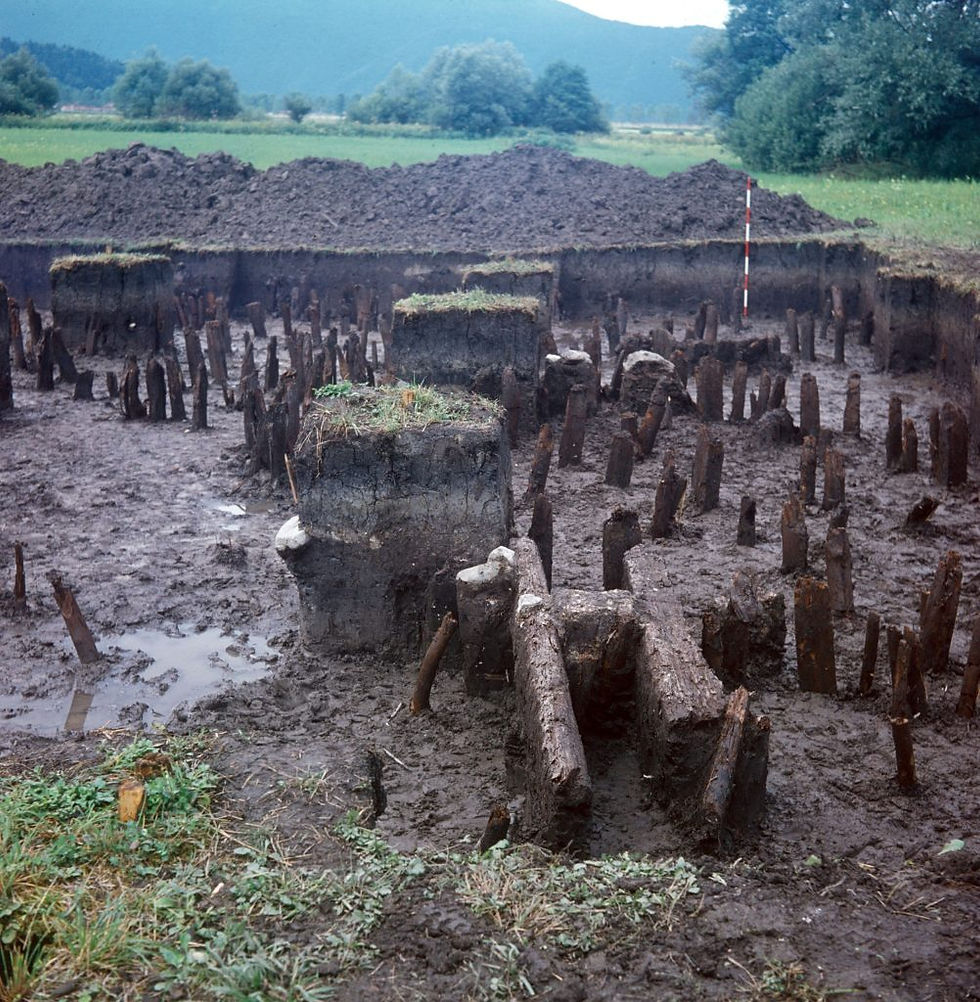Dawn of Civilization
- kapjasa
- Oct 29, 2018
- 4 min read
Tens of housands of years ago the vast plain of Ljubljana Marshes was a lake. 120 square kilometres covered in water a couple of meters deep.

A kite aerial photo of Ljubljana Marshes and river Ižica from a couple of months ago.
Over the millenia river Ižica and others were intrepidly bringing material from the hills into the ever shallower lake - today the depth of river and lacustrine sediments in Ljubljana Marshes is in places over 20 meters thick! - and some 7.000 years ago a new animal appeared at its shores.
Homo sapiens.
The shallow lake was brimming with fish, there were varous food sources like water chestnut in and around it, and the lake itself was offering some security from wild animals and other humans - if you build a house on stilts in the middle of it. Naturally people were attracted to it.
In the beginning of the fifth millenium BC the industrious humans created a new type of settlement, a bunch of huts on a raised platform on stilts, driven deep in the lake bed. This was the first so-called pile dwelling at Ljubljana Marshes - close to the shore, beside the proto-Ižica river that was making its course in the shallows.
They did this right here, over 6.000 years ago:

Zelimeljscica channel from a kite. The oldest pile dwelling - Resnik channel site - in Ljubljana marshes was built in the immediate vicinity. Kite aerial photo, Canon A810 on a Rokkaku kite.
The river courses back then were quite different from today. They were meandering through the flat marshy plain, changing course almost every year. Later, when people started the enormous project of drying and meliorating Ljubljana Marshes, numerous channels were dug, and river courses were straighened in order to expediate the water flow.

Confluence of river Ižica and Smoligojnik channel from a kite. The river courses were much broader and ever changing back then.

LIDAR data of the pile dwellings area. Old river courses are visible, slowly meandering streams now confined to straight channels. The approximate location of kite aerial photos is lightly shaded.
And with all this channel digging and roadmaking, objects from the dawn of time started to appear.
First, some pottery and stone tools were discovered, and curious wooden remains that were identified as stilts, foundations for pile dwellings. Karel Dežman was the first archaeology buff to investigate these remains properly, and his finds of pottery idols are still fascinating.

Idols, vessels and tools from pile dwellings near Ig. Photo Tomaž Lauko, courtesy of National Museum of Slovenia.
After WWII the research into pile dwellings of Ljubljana Marshes grew, with ever more detailed explorations and digs.
Today we know for over 40 different pile dwelling settlements in Ljubljana Marshes, stretching in time from fifth to third millenium BC, from Neolithic and Eneolithic to late Bronze and early Iron Age. The earliest, like Resnik channel site, are part of Sava group of Lengyel culture (5th millenium BC), later ones are from Furchenstich culture and Stare gmajne group (4th millenium BC), the latest from Vucedol and Somogyvár-Vinkovci culture (3rd millenium BC).

Confluence of Ižica and Zelimeljscica rivers. Maybe an as-yet undiscovered pile dwelling lies right here!
So how did these pile dwellings look like? The simple huts were built on raised platforms above water, sitting on literary thousands of stilts. Those stilts were made from ash or oak, 8 - 10 cm in diameter, driven deep in the lake bottom.

Excavated stilts of Mahar channel pile dwelling. Courtesy of Museum and Galleries of Ljubljana Documentation.
On one platform stood a couple of huts, probably a dwelling of an immediate family. The settlement comprised a number of platforms, thus accomodating anywhere from 25 to 500 people.

Ground plan of Parte - Iscica pile dwelling (a) and distribution of stilts at Mahar channel pile dwelling (b). Courtesy of dr. Anton Veluscek, Institute of Archaeology ZRC SAZU.

A reconstruction of a typical pile dwelling. Courtesy of Ivan Rehar/Museum and Galleries of Ljubljana.

There was an idea to make a small pond in this clearing, and to recreate a pile dwelling on it.
Life on pile dwellings was as complex as it is today. There was a division of labour, there was family life, there was food, joy, sorrow and death. People were making clothes and tools, they were cooking and eating, there were metalworks, stoneworks, woodworks ... Pile-dwellers had herds of cattle, they were catching fish, they had some agriculture, and they collected plentiful fruits of nature.

Still visible stilts in Ižica river (left), and ancient textile made from grass (Poacea ssp.).
One of the most fascinating finds from the pile-dwellers time are logboats (monoxyls), made from a single tree trunk with stone amd bronze axes.

An ancient logboat being excavated. Courtesy of Institute of Archaeology ZRC SAZU.
But the most crazy find of them all is this:

Photo by Andrej Peunik/courtesy of Museum and Galleries of Ljubljana.
A wooden wheel - with axis! -, the oldest known wooden wheel in the world! It's 5.200 years old and is indicative of the beginning of the end of pile dwellings: the lake was about to dry up completely, logboats were slowly replaced by carriages on wheels like this one, and pile dwellings were abandoned one by one. People moved to dry land - and the rest is history.
The importance of pile dwellings of Ljubljana Marshes was acknowledged by UNESCO; they were inscribed on the UNESCO World Heritage list in 2011, as a part of multinational WH site Pile Dwellings around the Alps.

Imagine people living here, fishing, making tools and clothes, rowing their logboats .... thousands of years ago.
All kite aerial photos were shot with Canon A810 on a Rokkaku kite.




Comments